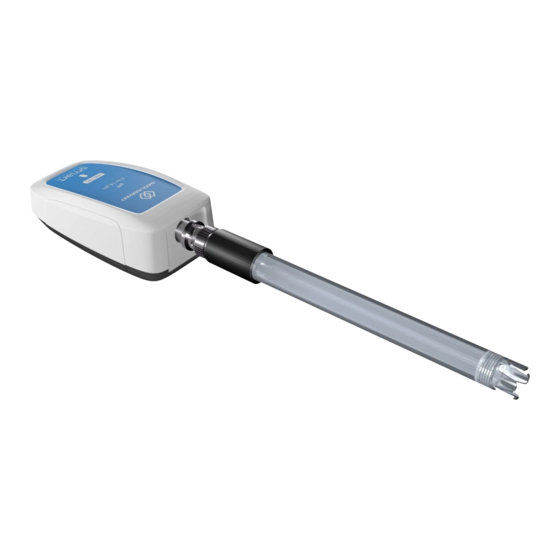Data Harvest Smart Wireless 1110 Handmatig - Pagina 6
Blader online of download pdf Handmatig voor {categorie_naam} Data Harvest Smart Wireless 1110. Data Harvest Smart Wireless 1110 16 pagina's. Ph sensor

Practical information
This general purpose electrode is non-refillable
Keep the pH sensitive membrane wet at all times. For the ion exchange process to occur properly,
the glass needs to be hydrated. Check and maintain the level of storage solution.
If the electrode should inadvertently become dry, place in the storage solution for several hours in
an attempt to recondition the glass.
Care should be taken to avoid handling the pH sensitive glass membrane. Any damage to the
surface, such as abrasion, may cause inaccuracies and result in a slow response time.
Stirring of a sample will achieve a faster electrode response, but the glass membrane tip is very thin
and requires care to prevent accidental damage. Broken glass bulbs are not covered by warranty.
Some magnetic stirrers can generate sufficient heat to change the temperature of the test
solution. If this is the case place a piece of insulation material such as polystyrene under the
beaker.
The working temperature of the pH electrode is 0 to 80˚C. The operating range of the adaptor is
0 to 40˚C and 0 to 95% RH (non-condensing). Do not subject to extreme heat or cold.
The pH adaptor is not waterproof. It may be cleaned using a damp cloth. Do not immerse in
water or detergent
Do not place the pH adaptor in an environment in which high humidity levels are possible as this
may result in damage or malfunction
If the sensor has been left in the cold, let it warm to near room temperature before waking it
from sleep.
Do not expose to direct sunlight for extended periods of time.
pH electrodes have a finite lifespan due to their inherent properties. How long a pH electrode will
last will depend on how it is cared for and the solutions it is used to measure. Even if the
electrode is not used, it will still age.
Always use freshly prepared pH buffers. When not in use, pH buffers should be stored in sealed
containers. High pH buffers are less stable as they tend to absorb atmospheric CO
their pH. During calibration only open the bottle of buffer to pour it into a beaker. Never leave the
bottle open.
Buffers and sample solution should be at the same temperature when measuring pH. The
resistance of glass electrodes partially depends on temperature. The lower the temperature, the
higher the resistance. It will take more time for the reading to stabilise if temperatures are cold.
To allow the pH adaptor to be used with any suitable pH electrodes with a BNC connector,
automatic temperature compensation has not been built in.
This sensor can also be used with alternative probes, such as Ion Selective Electrodes (ISE) and the
Oxidation Reduction Potent (ORP) Probes using the mV range.
Conditions to avoid:
Never store the electrode in deionised or distilled water, as this will cause the migration of the
electrode's fill solution.
To maximise electrode life, avoid pH/ temperature extremes whenever possible. High temperature,
strong acids or caustics (greater than 1.0 mol dm
temperatures, the electrodes life is drastically reduced. The higher the range of temperature, the
shorter the life of the electrode e.g. typical electrode life when used at ambient temperature is 1 – 3
years, if used at 80˚C this will be reduced to less than 4 months.
Never expose to temperatures below -12˚C, freezing will damage the electrode.
pH Adaptor & Electrode
-3
) shorten electrode life. If used at high
6
which lowers
2
